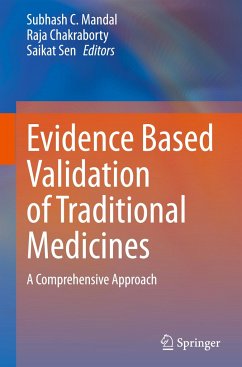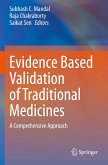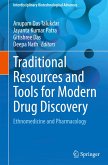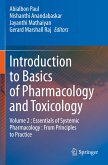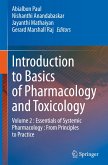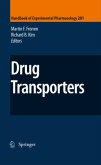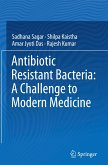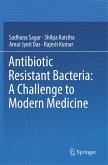Evidence Based Validation of Traditional Medicines
A comprehensive Approach
Herausgegeben:Mandal, Subhash C; Chakraborty, Raja; Sen, Saikat
Evidence Based Validation of Traditional Medicines
A comprehensive Approach
Herausgegeben:Mandal, Subhash C; Chakraborty, Raja; Sen, Saikat
- Gebundenes Buch
- Merkliste
- Auf die Merkliste
- Bewerten Bewerten
- Teilen
- Produkt teilen
- Produkterinnerung
- Produkterinnerung
The demand for traditional medicines, herbal health products, herbal pharmaceuticals, nutraceuticals, food supplements and herbal cosmetics etc. is increasing globally due to the growing recognition of these products as mainly non-toxic, having lesser side effects, better compatibility with physiological flora, and availability at affordable prices. In the last century, medical science has made incredible advances all over the globe. In spite of global reorganization and a very sound history of traditional uses, the promotion of traditional medicine faces a number of challenges around the…mehr
Andere Kunden interessierten sich auch für
![Evidence Based Validation of Traditional Medicines Evidence Based Validation of Traditional Medicines]() Evidence Based Validation of Traditional Medicines161,99 €
Evidence Based Validation of Traditional Medicines161,99 €![Traditional Resources and Tools for Modern Drug Discovery Traditional Resources and Tools for Modern Drug Discovery]() Traditional Resources and Tools for Modern Drug Discovery150,99 €
Traditional Resources and Tools for Modern Drug Discovery150,99 €![Introduction to Basics of Pharmacology and Toxicology Introduction to Basics of Pharmacology and Toxicology]() Introduction to Basics of Pharmacology and Toxicology178,99 €
Introduction to Basics of Pharmacology and Toxicology178,99 €![Introduction to Basics of Pharmacology and Toxicology Introduction to Basics of Pharmacology and Toxicology]() Introduction to Basics of Pharmacology and Toxicology178,99 €
Introduction to Basics of Pharmacology and Toxicology178,99 €![Drug Transporters Drug Transporters]() Drug Transporters223,99 €
Drug Transporters223,99 €![Antibiotic Resistant Bacteria: A Challenge to Modern Medicine Antibiotic Resistant Bacteria: A Challenge to Modern Medicine]() Sadhana SagarAntibiotic Resistant Bacteria: A Challenge to Modern Medicine113,99 €
Sadhana SagarAntibiotic Resistant Bacteria: A Challenge to Modern Medicine113,99 €![Antibiotic Resistant Bacteria: A Challenge to Modern Medicine Antibiotic Resistant Bacteria: A Challenge to Modern Medicine]() Sadhana SagarAntibiotic Resistant Bacteria: A Challenge to Modern Medicine112,99 €
Sadhana SagarAntibiotic Resistant Bacteria: A Challenge to Modern Medicine112,99 €-
-
-
The demand for traditional medicines, herbal health products, herbal pharmaceuticals, nutraceuticals, food supplements and herbal cosmetics etc. is increasing globally due to the growing recognition of these products as mainly non-toxic, having lesser side effects, better compatibility with physiological flora, and availability at affordable prices. In the last century, medical science has made incredible advances all over the globe. In spite of global reorganization and a very sound history of traditional uses, the promotion of traditional medicine faces a number of challenges around the globe, primarily in developed nations. Regulation and safety is the high concern for the promotion of traditional medicine. Quality issues and quality control, pharmacogivilane, scientific investigation and validation, intellectual property rights, and biopiracy are some key issues that restrain the advancement of traditional medicine around the globe. This book contains diverse and unique chapters, explaining in detail various subsections like phytomolecule, drug discovery and modern techniques, standardization and validation of traditional medicine, and medicinal plants, safety and regulatory issue of traditional medicine, pharmaceutical excipients from nature, plants for future. The contents of the book will be useful for the academicians, researchers and people working in the area of traditional medicine.
Hinweis: Dieser Artikel kann nur an eine deutsche Lieferadresse ausgeliefert werden.
Hinweis: Dieser Artikel kann nur an eine deutsche Lieferadresse ausgeliefert werden.
Produktdetails
- Produktdetails
- Verlag: Springer / Springer Nature Singapore / Springer, Berlin
- Artikelnr. des Verlages: 978-981-15-8126-7
- 1st edition 2021
- Seitenzahl: 1168
- Erscheinungstermin: 19. Januar 2021
- Englisch
- Abmessung: 241mm x 160mm x 68mm
- ISBN-13: 9789811581267
- ISBN-10: 9811581266
- Artikelnr.: 59889695
- Herstellerkennzeichnung Die Herstellerinformationen sind derzeit nicht verfügbar.
- Verlag: Springer / Springer Nature Singapore / Springer, Berlin
- Artikelnr. des Verlages: 978-981-15-8126-7
- 1st edition 2021
- Seitenzahl: 1168
- Erscheinungstermin: 19. Januar 2021
- Englisch
- Abmessung: 241mm x 160mm x 68mm
- ISBN-13: 9789811581267
- ISBN-10: 9811581266
- Artikelnr.: 59889695
- Herstellerkennzeichnung Die Herstellerinformationen sind derzeit nicht verfügbar.
Prof. (Dr.) Subhash C Mandal is currently working as a Professor at Division of Pharmacognosy, Department of Pharmaceutical Technology, Jadavpur University, Kolkata India since 1997. His research achievements have been duly honored by many international organizations for awards. He has guided more than 30 PhD scholars and 25 M Pharm scholars and has completed 12 government-funded research projects on Indian Traditional Medicines and Drug Discovery. Prof. Mandal has more than 300 research publications (Citations: 14446, h-index : 59, i10-index : 322), 08 patents and several authored, edited and book chapters to his credit. He has visited more than 30 countries for various scientific deliberations, collaborations exchange programmes. Dr. Raja Chakraborty is presently designated as Professor and Principal at NEF College of Pharmacy, Guwahati, Assam, India. He received his PhD in Pharmaceutical Sciences from Jawaharlal Nehru Technological University Anantapur, Indiain 2014. With 12 years of academic and research experience, he has published more than 60 research and review articles in reputed national and international journals. He authored two books "Tribal Medicinal Plants of Tripura, India: A scientific Search, Serial Publications, New Delhi and Diabetes Mellitus in 21st Century. Springer Singapore. He acted as editor for two books and nineteen book chapters with different national and international publishers. Recently he received "Dr. APJ Abdul Kalam Award for Teaching Excellence - 2018" He is guiding a number of Ph.D students and serving as Co-PI in a DBT-funded mega-project. Dr. Saikat Sen is an educationist and researcher, presently working as a professor at the Faculty of Pharmaceutical Sciences at Assam down town University, Guwahati. He has authored, and edited, various books and contributed chapters in different peer-reviewed edited books published by international/national publishers. More than 60 researchand review articles in peer-reviewed reputed national/international journals were added to his credit, presented several scientific papers, attended a number of national and international conferences, and delivered invitee lectures in international forums. He has received several awards during his 12 years of his professional carrier which include Sushruta Best Young Scientist Award, Dr. APJ Abdul Kalam Award for Young Scientists - 2018. He is a member of different professional bodies around the world and involve enthusiastically in scientific research on traditional/folk medicinal systems and to develop active research culture.
Chapter 1. Global Approach for Drug Discovery and Development from Indian Traditional Medicine.- Chapter 2. Bioactive Natural Leads TargetingCancer Cell Metabolism.- Chapter 3. Omics Technologies and Development of Anti-diabetic Therapies from Prospective Natural Products.- Chapter 4. Amaryllidaceae Alkaloids as Anti-inflammatory Agents Targeting Cholinergic Anti-inflammatory Pathway: Mechanisms and Prospects.- Chapter 5. Neurodegenerative Diseases and Small Molecule Protein Chaperone Activator of Natural Origin.- Chapter 6. Role of Phytomolecules on the Basic Biology of Aging.- Chapter 7. Role of phytomedicine in alleviating oxidative stress mediated vascular complications in diabetes.- Chapter 8. Plant Based -Secretase (BACE-1) Inhibitors: A Mechanistic Approach to Encounter Alzheimer's Disorder.- Chapter 9. Bioactive Compounds of Mangroves as Potent Drug and in Nanoparticle Synthesis - Play a Pivotal Role in Combating Human Pathogens. Chapter 10. Medicinal Plants: A Rich Source ofBioactive Molecules Used in Drug Development.- Chapter 11. Cell-based Assays in Natural Product-based Drug Discovery.- Chapter 12. Allelochemicals: An Emerging Tool for Weed Management.- Chapter 13. Secondary Metabolites of Higher Plants as Green Preservatives of Herbal Raw Materials and Their Active Principles During Postharvest Processing.- Chapter 14. Importance of Chromatography Techniques in Phytomedicine Research.- Chapter 15. Reverse Pharmacology - A Tool for Drug Discovery From Traditional Medicine.- Chapter 16. Role of Modern Biological Techniques in Evidence-Based Validation of Ayurvedic Herbometallic Preparations.- Chapter 17. HPTLC Fingerprinting analysis of Phytoconstituents from Indigenous Medicinal Plants.- Chapter 18. Climate Change,Geographical Location and Other Allied Triggering Factors Modulate the Standardization and Characterization of Traditional Medicinal Plants: AChallenges and Prospect for Phyto-Drug Development.- Chapter 19. Molecular Docking Studies of Plant-Derived Bioactive Compounds: A Comprehensive in silico Standardization Approach.- Chapter 20. Standardization and Quality Evaluation of Botanicals with Special Reference to Marker Components.- Chapter 21. Analytical Standardization of Haridra Formulation by UV-VIS Spectrophotometry and RP-HPLC.- Chapter 22. Ethnobotanical survey: the foundation to evidence based validation of medicinal plants.- Chapter 23. Phytotherapeutics: The Rising Role of Drug Transporters in Herb-Drug Interactions with Botanical Supplements.- Chapter 24. An Insight into Herb Interactions: Clinical Evidence Based Overview.- Chapter 25. Pharmacovigilance of Herbal Medicines: An Overview.- Chapter 26. Herbal Drugs: Efficacy, Toxicity and Safety Issues.- Chapter 27. Herbal Drug Patenting.- Chapter 28. Safety and Regulatory Issues on Traditional Medicine Entrusted Drug Discovery.- Chapter 29. Pharmacovigilance of Herbal Medicine: An Evolving Discipline.- Chapter 30. Toxicity Studies Related to Medicinal Plants.- Chapter 31. Herb-Drug Interactions.- Chapter 32. Plant Based Traditional Herbal Contraceptive Use in India: Safety and Regulatory Issues.- Chapter 33. Traditional Medicine Stability and Pharmacokinetic Issue.- Chapter 34. Pharmacovigilance: Methods in developing the safety and acceptability of traditional medicines.- Chapter 35. Zoopharmacognosy (Plant-Animal Interaction).- Chapter 36. Significance of Stability and Pharmacokinetic issues in Traditional Medicine.- Chapter 37. Pharmaceutical Formulations Development Based on the Polymers Obtained from Edible Plants: An Excellent Approach for the Betterment in Health Care Services.- Chapter 38. Evaluation of bioactivity of green nanoparticles synthesized from traditionally used medicinal plants: a review.- Chapter 39. Physicochemical, Micromeritics, Biomedical and Pharmaceutical Applications of Assam Bora Rice Starch.- Chapter 40. Natural Excipients in Pharmaceutical Formulations.- Chapter 41. A Wonder Plant Withania: Pharmacological and Chemical Perspectives.- Chapter 42. Immunomodulators and Phyto Drugs.- Chapter 43. Combined Effects of Plant Extracts on Ovarian Cell Functioning.- Chapter 44. Pterocarpussantalinus: A Wonder Gift of Nature.- Chapter 45. Phytochemicals And Investigations On Traditionally Used Medicinal Mushrooms.- Chapter 46. A Review On Investigational Studies Of Marine Macroalgae Spogomorpha Indica L.- Chapter 47. Validation of Traditional Claim of Oxalis debilis Kunth., An Ethnomedicinal Plant from North-eastern Region of India.- Chapter 48. Traditional Herbal Medicine Practiced in Plateau-Fringe and Rarh Districts of West Bengal, India.- Chapter 49. Pharmacology and Mechanisms of Natural Medicine in Treatment of Type 2 Diabetes Mellitus.- Chapter 50. Indian Traditional Herbs and Alzheimer's Disease: Integrating Ethnobotany and Phytotherapy.
Chapter 1. Global Approach for Drug Discovery and Development from Indian Traditional Medicine.- Chapter 2. Bioactive Natural Leads TargetingCancer Cell Metabolism.- Chapter 3. Omics Technologies and Development of Anti-diabetic Therapies from Prospective Natural Products.- Chapter 4. Amaryllidaceae Alkaloids as Anti-inflammatory Agents Targeting Cholinergic Anti-inflammatory Pathway: Mechanisms and Prospects.- Chapter 5. Neurodegenerative Diseases and Small Molecule Protein Chaperone Activator of Natural Origin.- Chapter 6. Role of Phytomolecules on the Basic Biology of Aging.- Chapter 7. Role of phytomedicine in alleviating oxidative stress mediated vascular complications in diabetes.- Chapter 8. Plant Based -Secretase (BACE-1) Inhibitors: A Mechanistic Approach to Encounter Alzheimer's Disorder.- Chapter 9. Bioactive Compounds of Mangroves as Potent Drug and in Nanoparticle Synthesis - Play a Pivotal Role in Combating Human Pathogens. Chapter 10. Medicinal Plants: A Rich Source ofBioactive Molecules Used in Drug Development.- Chapter 11. Cell-based Assays in Natural Product-based Drug Discovery.- Chapter 12. Allelochemicals: An Emerging Tool for Weed Management.- Chapter 13. Secondary Metabolites of Higher Plants as Green Preservatives of Herbal Raw Materials and Their Active Principles During Postharvest Processing.- Chapter 14. Importance of Chromatography Techniques in Phytomedicine Research.- Chapter 15. Reverse Pharmacology - A Tool for Drug Discovery From Traditional Medicine.- Chapter 16. Role of Modern Biological Techniques in Evidence-Based Validation of Ayurvedic Herbometallic Preparations.- Chapter 17. HPTLC Fingerprinting analysis of Phytoconstituents from Indigenous Medicinal Plants.- Chapter 18. Climate Change,Geographical Location and Other Allied Triggering Factors Modulate the Standardization and Characterization of Traditional Medicinal Plants: AChallenges and Prospect for Phyto-Drug Development.- Chapter 19. Molecular Docking Studies of Plant-Derived Bioactive Compounds: A Comprehensive in silico Standardization Approach.- Chapter 20. Standardization and Quality Evaluation of Botanicals with Special Reference to Marker Components.- Chapter 21. Analytical Standardization of Haridra Formulation by UV-VIS Spectrophotometry and RP-HPLC.- Chapter 22. Ethnobotanical survey: the foundation to evidence based validation of medicinal plants.- Chapter 23. Phytotherapeutics: The Rising Role of Drug Transporters in Herb-Drug Interactions with Botanical Supplements.- Chapter 24. An Insight into Herb Interactions: Clinical Evidence Based Overview.- Chapter 25. Pharmacovigilance of Herbal Medicines: An Overview.- Chapter 26. Herbal Drugs: Efficacy, Toxicity and Safety Issues.- Chapter 27. Herbal Drug Patenting.- Chapter 28. Safety and Regulatory Issues on Traditional Medicine Entrusted Drug Discovery.- Chapter 29. Pharmacovigilance of Herbal Medicine: An Evolving Discipline.- Chapter 30. Toxicity Studies Related to Medicinal Plants.- Chapter 31. Herb-Drug Interactions.- Chapter 32. Plant Based Traditional Herbal Contraceptive Use in India: Safety and Regulatory Issues.- Chapter 33. Traditional Medicine Stability and Pharmacokinetic Issue.- Chapter 34. Pharmacovigilance: Methods in developing the safety and acceptability of traditional medicines.- Chapter 35. Zoopharmacognosy (Plant-Animal Interaction).- Chapter 36. Significance of Stability and Pharmacokinetic issues in Traditional Medicine.- Chapter 37. Pharmaceutical Formulations Development Based on the Polymers Obtained from Edible Plants: An Excellent Approach for the Betterment in Health Care Services.- Chapter 38. Evaluation of bioactivity of green nanoparticles synthesized from traditionally used medicinal plants: a review.- Chapter 39. Physicochemical, Micromeritics, Biomedical and Pharmaceutical Applications of Assam Bora Rice Starch.- Chapter 40. Natural Excipients in Pharmaceutical Formulations.- Chapter 41. A Wonder Plant Withania: Pharmacological and Chemical Perspectives.- Chapter 42. Immunomodulators and Phyto Drugs.- Chapter 43. Combined Effects of Plant Extracts on Ovarian Cell Functioning.- Chapter 44. Pterocarpussantalinus: A Wonder Gift of Nature.- Chapter 45. Phytochemicals And Investigations On Traditionally Used Medicinal Mushrooms.- Chapter 46. A Review On Investigational Studies Of Marine Macroalgae Spogomorpha Indica L.- Chapter 47. Validation of Traditional Claim of Oxalis debilis Kunth., An Ethnomedicinal Plant from North-eastern Region of India.- Chapter 48. Traditional Herbal Medicine Practiced in Plateau-Fringe and Rarh Districts of West Bengal, India.- Chapter 49. Pharmacology and Mechanisms of Natural Medicine in Treatment of Type 2 Diabetes Mellitus.- Chapter 50. Indian Traditional Herbs and Alzheimer's Disease: Integrating Ethnobotany and Phytotherapy.

